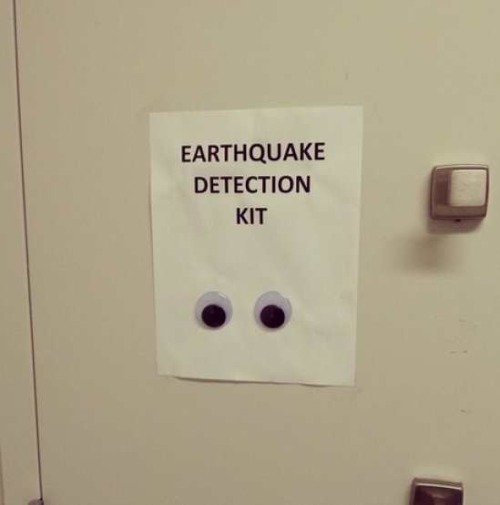In An Experiment, Two Ravens Had To Simultaneously Pull The Two Ends Of One Rope To Slide A Platform
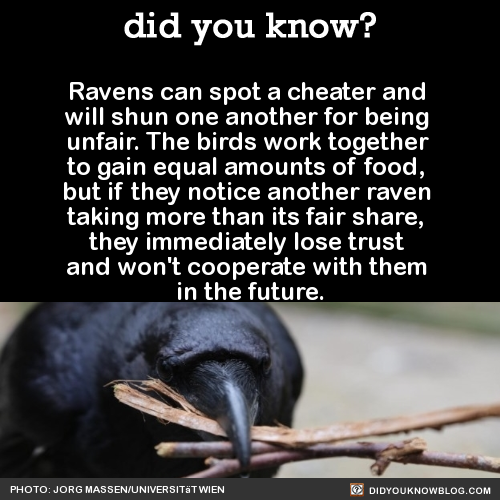
In an experiment, two ravens had to simultaneously pull the two ends of one rope to slide a platform with two pieces of cheese into reach. If only one of them pulled, the rope would slip through the loops, leaving them with no cheese. Without any training they solved the task and cooperated successfully.

However, when one of the two birds cheated and stole the reward of its companion, the victims of such cheats immediately noticed and started defecting in further trials with the same individual.

“Such a sophisticated way of keeping your partner in check has previously only been shown in humans and chimpanzees, and is a complete novelty among birds.”

Source
More Posts from Science-is-magical and Others

Redrawing the brain’s motor map
Neuroscientists at Emory have refined a map showing which parts of the brain are activated during head rotation, resolving a decades-old puzzle. Their findings may help in the study of movement disorders affecting the head and neck, such as cervical dystonia and head tremor.
The results were published in Journal of Neuroscience.
In landmark experiments published in the 1940s and 50s, Canadian neurosurgeon Wilder Penfield and colleagues determined which parts of the motor cortex controlled the movements of which parts of the body.
Penfield stimulated the brain with electricity in patients undergoing epilepsy surgery, and used the results to draw a “motor homunculus”: a distorted representation of the human body within the brain. Penfield assigned control of the neck muscles to a region between those that control the fingers and face, a finding inconsistent with some studies that came later.
Using modern functional MRI (magnetic resonance imaging), researchers at Emory University School of Medicine have shown that the neck’s motor control region in the brain is actually between the shoulders and trunk, a location that more closely matches the arrangement of the body itself.
“We can’t be that hard on Penfield, because the number of cases where he was able to study head movement was quite limited, and studying head motion as he did, by applying an electrode directly to the brain, creates some challenges,” says lead author Buz Jinnah, MD, professor of neurology, human genetics and pediatrics at Emory University School of Medicine.
The new location for the neck muscles makes more sense, because it corresponds to a similar map Penfield established of the sense of touch (the somatosensory cortex), Jinnah says.
Participants in brain imaging studies need to keep their heads still to provide accurate data, so volunteers were asked to perform isometric muscle contraction. They attempted to rotate their heads to the left or the right, even though head movement was restricted by foam padding and restraining straps.
First author Cecilia Prudente, a graduate student in neuroscience who is now a postdoctoral associate at the University of Minnesota, developed the isometric head movement task and obtained internal funding that allowed the study to proceed.
She and Jinnah knew that isometric exercises for the wrist activated the same regions of the motor cortex as wrist movements, and used that as a reference point in their study. During brain imaging, they were able to check that particular muscles were being tensed by directly monitoring volunteers’ muscles electronically.
When volunteers contracted their neck muscles, researchers were able to detect activation in other parts of the brain too, such as the cerebellum and the basal ganglia, which are known to be involved in movement control. This comes as no surprise, Jinnah says, since these regions also control movements of the hands and other body parts.
Prudente, Jinnah and colleagues have conducted a similar study with cervical dystonia patients, with the goal of comparing the patterns of brain activation between healthy volunteers and the patients. Cervical dystonia is a painful condition in which the neck muscles contract involuntarily and the head posture is distorted.
“These results may help guide future studies in humans and animals, as well as medical or surgical interventions for cervical dystonia and other disorders involving abnormal head movements,” Prudente says.



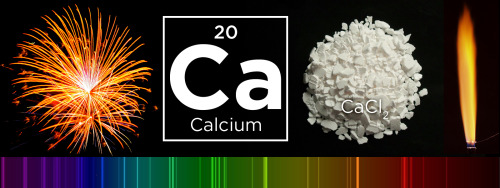
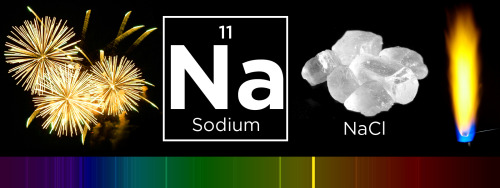
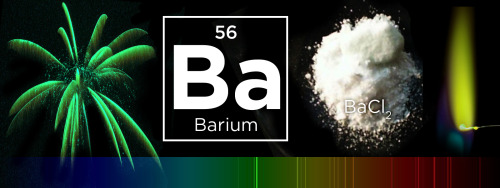
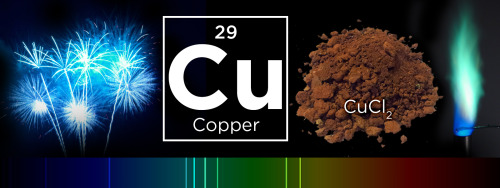
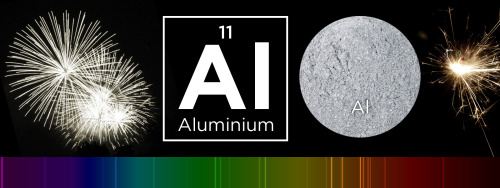
What makes fireworks colorful?
It’s all thanks to the luminescence of metals. When certain metals are heated (over a flame or in a hot explosion) their electrons jump up to a higher energy state. When those electrons fall back down, they emit specific frequencies of light - and each chemical has a unique emission spectrum.
You can see that the most prominent bands in the spectra above match the firework colors. The colors often burn brighter with the addition of an electron donor like Chlorine (Cl).
But the metals alone wouldn’t look like much. They need to be excited. Black powder (mostly nitrates like KNO3) provides oxygen for the rapid reduction of charcoal © to create a lot hot expanding gas - the BOOM. That, in turn, provides the energy for luminescence - the AWWWW.
Aluminium has a special role — it emits a bright white light … and makes sparks!
Images: Charles D. Winters, Andrew Lambert Photography / Science Source, iStockphoto, Epic Fireworks, Softyx, Mark Schellhase, Walkerma, Firetwister, Rob Lavinsky, iRocks.com, Søren Wedel Nielsen
ELI5:How come people can't be cryogenically frozen safely as the ice crystals destroy the cell membranes, but sex cells such as sperm are kept frozen for long periods of time yet remain functional?
I work in a lab where we freeze down cells all of the time. We freeze our cells in a medium that contains 5% DMSO, which among other things can be used as a cryoprotectant. However, DMSO is also toxic to cells at the concentrations necessary for cryoprotection. Consequently, when you freeze cells in DMSO, you add the DMSO medium at ice-cold temperatures and don’t allow the cells to warm up. When you later thaw the cells, you have to dilute out the DMSO as quickly as possible without causing osmotic shock, which can pop the cells. Such restrictions on freezing and thawing would basically be impossible to control at the level of a complete organism.
However, to contradict a lot of previous posts, individual cells can be recovered from freezing with high viability. When performed properly (and this varies quite a bit by cell type), you can expect >90% of cells to be alive following thaw.
The chemicals that allow cells to survive freezing are toxic to the body. Keeping the cells cold minimized the damage that this chemical does to the cells. With single cell solutions, adding the chemical at ice-cold temperatures and immediately diluting it out when you thaw the cells can keep 90% of the cells alive. There’s no way to do this with an intact body.
It’s also worth noting that this is probably not the only reason that this technique doesn’t scale to organisms.
Explain Like I`m Five: good questions, best answers.

After the Battle of Shiloh in 1862, many Civil War soldiers’ lives were saved by a phenomenon called ‘Angel’s Glow.’ The soldiers, who lay in the mud for two rainy days, had wounds that began to glow in the dark and heal unusually fast. In 2001, 2 teens won an international science fair by discovering the soldiers had been so cold that their bodies created the perfect conditions for growing a bioluminescent bacteria, which ultimately destroyed the bad bacteria that could’ve killed them. Source Source 2 Source 3
Newly discovered windows of brain plasticity may help with treatment of stress-related disorders
Chronic stress can lead to changes in neural circuitry that leave the brain trapped in states of anxiety and depression. But even under repeated stress, brief opportunities for recovery can open up, according to new research at The Rockefeller University.

(Image caption: Routine versus disruptive: A familiar stressor (left) did not increase NMDA receptors (dark spots), a booster of potentially harmful glutamate signaling, in the brains of mice. However, when subjected to an unfamiliar stress (right), mice expressed more NMDA receptors)
“Even after a long period of chronic stress, the brain retains the ability to change and adapt. In experiments with mice, we discovered the mechanism that alters expression of key glutamate-controlling genes to make windows of stress-related neuroplasticity—and potential recovery—possible,” says senior author Bruce McEwen, Alfred E. Mirsky Professor, and head of the Harold and Margaret Milliken Hatch Laboratory of Neuroendocrinology. Glutamate is a chemical signal implicated in stress-related disorders, including depression.
“This sensitive window could provide an opportunity for treatment, when the brain is most responsive to efforts to restore neural circuitry in the affected areas,” he adds.
The team, including McEwen and first author Carla Nasca, wanted to know how a history of stress could alter the brain’s response to further stress. To find out, they accustomed mice to a daily experience they dislike, confinement in a small space for a short period. On the 22nd day, they introduced some of those mice to a new stressor; others received the now-familiar confinement.
Then, the researchers tested both groups for anxiety- or depression-like behaviors. A telling split emerged: Mice tested shortly after the receiving the familiar stressor showed fewer of those behaviors; meanwhile those given the unfamiliar stressor, displayed more. The difference was transitory, however; by 24 hours after the final stressor, the behavioral improvements seen in half of the mice had disappeared.
Molecular analyses revealed a parallel fluctuation in a part of the hippocampus, a brain region involved in the stress response. A key molecule, mGlu2, which tamps down the release of the neurotransmitter glutamate, increased temporarily in mice subjected to the familiar confinement stress. Meanwhile, a molecular glutamate booster, NMDA, increased in other mice that experienced the unfamiliar stressor. In stress-related disorders, excessive glutamate causes harmful structural changes in the brain.
The researchers also identified the molecule regulating the regulator, an enzyme called P300. By adding chemical groups to proteins known as histones, which give support and structure to DNA, P300 increases expression of mGlu2, they found.
In other experiments, they looked at mice genetically engineered to carry a genetic variant associated with development of depression and other stress-related disorders in humans, and present in 33 percent of the population.
“Here again, in experiments relevant to humans, we saw the same window of plasticity, with the same up-then-down fluctuations in mGlu2 and P300 in the hippocampus,” Nasca says. “This result suggests we can take advantage of these windows of plasticity through treatments, including the next generation of drugs, such as acetyl carnitine, that target mGlu2—not to ‘roll back the clock’ but rather to change the trajectory of such brain plasticity toward more positive directions.”
Magnetospheres: How Do They Work?
The sun, Earth, and many other planets are surrounded by giant magnetic bubbles.

Space may seem empty, but it’s actually a dynamic place, dominated by invisible forces, including those created by magnetic fields. Magnetospheres – the areas around planets and stars dominated by their magnetic fields – are found throughout our solar system. They deflect high-energy, charged particles called cosmic rays that are mostly spewed out by the sun, but can also come from interstellar space. Along with atmospheres, they help protect the planets’ surfaces from this harmful radiation.
It’s possible that Earth’s protective magnetosphere was essential for the development of conditions friendly to life, so finding magnetospheres around other planets is a big step toward determining if they could support life.
But not all magnetospheres are created equal – even in our own backyard, not all planets in our solar system have a magnetic field, and the ones we have observed are all surprisingly different.

Earth’s magnetosphere is created by the constantly moving molten metal inside Earth. This invisible “force field” around our planet has an ice cream cone-like shape, with a rounded front and a long, trailing tail that faces away from the sun. The magnetosphere is shaped that way because of the constant pressure from the solar wind and magnetic fields on the sun-facing side.

Earth’s magnetosphere deflects most charged particles away from our planet – but some do become trapped in the magnetic field and create auroras when they rain down into the atmosphere.

We have several missions that study Earth’s magnetosphere – including the Magnetospheric Multiscale mission, Van Allen Probes, and Time History of Events and Macroscale Interactions during Substorms (also known as THEMIS) – along with a host of other satellites that study other aspects of the sun-Earth connection.


Mercury, with a substantial iron-rich core, has a magnetic field that is only about 1% as strong as Earth’s. It is thought that the planet’s magnetosphere is stifled by the intense solar wind, limiting its strength, although even without this effect, it still would not be as strong as Earth’s. The MESSENGER satellite orbited Mercury from 2011 to 2015, helping us understand our tiny terrestrial neighbor.


After the sun, Jupiter has by far the biggest magnetosphere in our solar system – it stretches about 12 million miles from east to west, almost 15 times the width of the sun. (Earth’s, on the other hand, could easily fit inside the sun.) Jupiter does not have a molten metal core like Earth; instead, its magnetic field is created by a core of compressed liquid metallic hydrogen.

One of Jupiter’s moons, Io, has intense volcanic activity that spews particles into Jupiter’s magnetosphere. These particles create intense radiation belts and the large auroras around Jupiter’s poles.

Ganymede, Jupiter’s largest moon, also has its own magnetic field and magnetosphere – making it the only moon with one. Its weak field, nestled in Jupiter’s enormous shell, scarcely ruffles the planet’s magnetic field.
Our Juno mission orbits inside the Jovian magnetosphere sending back observations so we can better understand this region. Previous observations have been received from Pioneers 10 and 11, Voyagers 1 and 2, Ulysses, Galileo and Cassini in their flybys and orbits around Jupiter.

Saturn’s moon Enceladus transforms the shape of its magnetosphere. Active geysers on the moon’s south pole eject oxygen and water molecules into the space around the planet. These particles, much like Io’s volcanic emissions at Jupiter, generate the auroras around the planet’s poles. Our Cassini mission studies Saturn’s magnetic field and auroras, as well as its moon Enceladus.


Uranus’ magnetosphere wasn’t discovered until 1986 when data from Voyager 2’s flyby revealed weak, variable radio emissions. Uranus’ magnetic field and rotation axis are out of alignment by 59 degrees, unlike Earth’s, whose magnetic field and rotation axis differ by only 11 degrees. On top of that, the magnetic field axis does not go through the center of the planet, so the strength of the magnetic field varies dramatically across the surface. This misalignment also means that Uranus’ magnetotail – the part of the magnetosphere that trails away from the sun – is twisted into a long corkscrew.


Neptune’s magnetosphere is also tilted from its rotation axis, but only by 47. Just like on Uranus, Neptune’s magnetic field strength varies across the planet. This also means that auroras can be seen away from the planet’s poles – not just at high latitudes, like on Earth, Jupiter and Saturn.

Does Every Planet Have a Magnetosphere?
Neither Venus nor Mars have global magnetic fields, although the interaction of the solar wind with their atmospheres does produce what scientists call an “induced magnetosphere.” Around these planets, the atmosphere deflects the solar wind particles, causing the solar wind’s magnetic field to wrap around the planet in a shape similar to Earth’s magnetosphere.

What About Beyond Our Solar System?
Outside of our solar system, auroras, which indicate the presence of a magnetosphere, have been spotted on brown dwarfs – objects that are bigger than planets but smaller than stars.
There’s also evidence to suggest that some giant exoplanets have magnetospheres. As scientists now believe that Earth’s protective magnetosphere was essential for the development of conditions friendly to life, finding magnetospheres around exoplanets is a big step in finding habitable worlds.
Make sure to follow us on Tumblr for your regular dose of space: http://nasa.tumblr.com
-
 heckcareoxytwit liked this · 3 weeks ago
heckcareoxytwit liked this · 3 weeks ago -
 ghostconch liked this · 1 month ago
ghostconch liked this · 1 month ago -
 sealwhiskers reblogged this · 1 month ago
sealwhiskers reblogged this · 1 month ago -
 outbackranger108 liked this · 8 months ago
outbackranger108 liked this · 8 months ago -
 gothikaxenon reblogged this · 8 months ago
gothikaxenon reblogged this · 8 months ago -
 deviruo liked this · 9 months ago
deviruo liked this · 9 months ago -
 jahoolopy reblogged this · 9 months ago
jahoolopy reblogged this · 9 months ago -
 foxy-disaster liked this · 9 months ago
foxy-disaster liked this · 9 months ago -
 vintagedykenot2old reblogged this · 10 months ago
vintagedykenot2old reblogged this · 10 months ago -
 wirepaladin liked this · 10 months ago
wirepaladin liked this · 10 months ago -
 vuelvoenunparpadeo liked this · 10 months ago
vuelvoenunparpadeo liked this · 10 months ago -
 toothpaste-footlocker liked this · 10 months ago
toothpaste-footlocker liked this · 10 months ago -
 jahoolopy liked this · 10 months ago
jahoolopy liked this · 10 months ago -
 mlleclaudine reblogged this · 10 months ago
mlleclaudine reblogged this · 10 months ago -
 jnssq reblogged this · 10 months ago
jnssq reblogged this · 10 months ago -
 ihavemace reblogged this · 11 months ago
ihavemace reblogged this · 11 months ago -
 can-u-smell-that-thats-comedy reblogged this · 1 year ago
can-u-smell-that-thats-comedy reblogged this · 1 year ago -
 vo-kopen reblogged this · 1 year ago
vo-kopen reblogged this · 1 year ago -
 heckcareoxytwit reblogged this · 1 year ago
heckcareoxytwit reblogged this · 1 year ago -
 falterjay liked this · 1 year ago
falterjay liked this · 1 year ago -
 lupagrimm reblogged this · 1 year ago
lupagrimm reblogged this · 1 year ago -
 lupagrimm liked this · 1 year ago
lupagrimm liked this · 1 year ago -
 foreverapprentice liked this · 1 year ago
foreverapprentice liked this · 1 year ago -
 crawledintoanewbog reblogged this · 1 year ago
crawledintoanewbog reblogged this · 1 year ago -
 elizasoulmate liked this · 1 year ago
elizasoulmate liked this · 1 year ago -
 introverted-astrophile reblogged this · 1 year ago
introverted-astrophile reblogged this · 1 year ago -
 asteriusorion liked this · 1 year ago
asteriusorion liked this · 1 year ago -
 iwillhaveamoonbase liked this · 2 years ago
iwillhaveamoonbase liked this · 2 years ago -
 whorerrshow liked this · 2 years ago
whorerrshow liked this · 2 years ago -
 eyeball-freak liked this · 2 years ago
eyeball-freak liked this · 2 years ago -
 tobeavirginian liked this · 2 years ago
tobeavirginian liked this · 2 years ago -
 sealwhiskers reblogged this · 2 years ago
sealwhiskers reblogged this · 2 years ago -
 fallen-starr liked this · 2 years ago
fallen-starr liked this · 2 years ago -
 checkpleasetrashh reblogged this · 2 years ago
checkpleasetrashh reblogged this · 2 years ago -
 checkpleasetrashh liked this · 2 years ago
checkpleasetrashh liked this · 2 years ago -
 felinalain reblogged this · 2 years ago
felinalain reblogged this · 2 years ago -
 avid-amelioration-blog liked this · 2 years ago
avid-amelioration-blog liked this · 2 years ago -
 knifecrow reblogged this · 2 years ago
knifecrow reblogged this · 2 years ago -
 knifecrow liked this · 2 years ago
knifecrow liked this · 2 years ago -
 sir-david-von-templo liked this · 2 years ago
sir-david-von-templo liked this · 2 years ago





